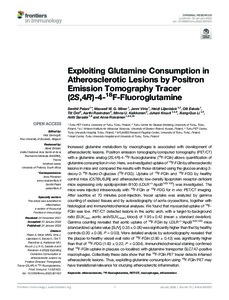| dc.contributor.author | Miner Maxwell W. G. | |
| dc.contributor.author | Palani Senthil | |
| dc.contributor.author | Ravindran Aarthi | |
| dc.contributor.author | Knuuti Juhani | |
| dc.contributor.author | Roivainen Anne | |
| dc.contributor.author | Virta Jenni | |
| dc.contributor.author | Liljenbäck Heidi | |
| dc.contributor.author | Örd Tiit | |
| dc.contributor.author | Kaikkonen Mnna U. | |
| dc.contributor.author | Eskola Olli | |
| dc.contributor.author | Saraste Antti | |
| dc.contributor.author | Li Xiang-Guo | |
| dc.date.accessioned | 2022-10-28T12:33:50Z | |
| dc.date.available | 2022-10-28T12:33:50Z | |
| dc.identifier.uri | https://www.utupub.fi/handle/10024/160430 | |
| dc.description.abstract | Increased glutamine metabolism by macrophages is associated with development of atherosclerotic lesions. Positron emission tomography/computed tomography (PET/CT) with a glutamine analog (2S,4R)-4-F-18-fluoroglutamine (F-18-FGln) allows quantification of glutamine consumption in vivo. Here, we investigated uptake of F-18-FGln by atherosclerotic lesions in mice and compared the results with those obtained using the glucose analog 2-deoxy-2-F-18-fluoro-D-glucose (F-18-FDG). Uptake of F-18-FGln and F-18-FDG by healthy control mice (C57BL/6JRj) and atherosclerotic low-density lipoprotein receptor-deficient mice expressing only apolipoprotein B100 (LDLR(-/-)ApoB(100/100)) was investigated. The mice were injected intravenously with F-18-FGln or F-18-FDG for in vivo PET/CT imaging. After sacrifice at 70 minutes post-injection, tracer uptake was analyzed by gamma counting of excised tissues and by autoradiography of aorta cryosections, together with histological and immunohistochemical analyses. We found that myocardial uptake of F-18-FGln was low. PET/CT detected lesions in the aortic arch, with a target-to-background ratio (SUVmax, aortic arch/SUVmean, blood) of 1.95 +/- 0.42 (mean +/- standard deviation). Gamma counting revealed that aortic uptake of F-18-FGln by LDLR(-/-)ApoB(100/100) mice (standardized uptake value [SUV], 0.35 +/- 0.06) was significantly higher than that by healthy controls (0.20 +/- 0.08, P = 0.03). More detailed analysis by autoradiography revealed that the plaque-to-healthy vessel wall ratio of F-18-FGln (2.90 +/- 0.42) was significantly higher than that of F-18-FDG (1.93 +/- 0.22, P = 0.004). Immunohistochemical staining confirmed that F-18-FGln uptake in plaques co-localized with glutamine transporter SLC7A7-positive macrophages. Collectively these data show that the F-18-FGln PET tracer detects inflamed atherosclerotic lesions. Thus, exploiting glutamine consumption using F-18-FGln PET may have translational relevance for studying atherosclerotic inflammation. | |
| dc.language.iso | en | |
| dc.publisher | FRONTIERS MEDIA SA | |
| dc.title | Exploiting Glutamine Consumption in Atherosclerotic Lesions by Positron Emission Tomography Tracer (2S,4R)-4-F-18-Fluoroglutamine | |
| dc.identifier.url | https://www.frontiersin.org/articles/10.3389/fimmu.2022.821423/full | |
| dc.identifier.urn | URN:NBN:fi-fe2022081154113 | |
| dc.relation.volume | 13 | |
| dc.contributor.organization | fi=PET tutkimus|en=PET Research| | |
| dc.contributor.organization | fi=sisätautioppi|en=Internal Medicine| | |
| dc.contributor.organization | fi=InFLAMES lippulaiva, tutkimus|en=InFLAMES Flagship, research| | |
| dc.contributor.organization | fi=PET perustoiminta|en=PET Basic Operations| | |
| dc.contributor.organization | fi=tyks, vsshp|en=tyks, vsshp| | |
| dc.contributor.organization-code | 2609810 | |
| dc.contributor.organization-code | 2607318 | |
| dc.contributor.organization-code | 2609820 | |
| dc.contributor.organization-code | 2607051 | |
| dc.converis.publication-id | 174794669 | |
| dc.converis.url | https://research.utu.fi/converis/portal/Publication/174794669 | |
| dc.identifier.jour-issn | 1664-3224 | |
| dc.okm.affiliatedauthor | Miner, Maxwell | |
| dc.okm.affiliatedauthor | Liljenbäck, Heidi | |
| dc.okm.affiliatedauthor | Palani, Senthil | |
| dc.okm.affiliatedauthor | Saraste, Antti | |
| dc.okm.affiliatedauthor | Li, Xiang-Guo | |
| dc.okm.affiliatedauthor | Virta, Jenni | |
| dc.okm.affiliatedauthor | Eskola, Olli | |
| dc.okm.affiliatedauthor | Dataimport, tyks, vsshp | |
| dc.okm.affiliatedauthor | Roivainen, Anne | |
| dc.okm.affiliatedauthor | Knuuti, Juhani | |
| dc.okm.discipline | 3126 Surgery, anesthesiology, intensive care, radiology | en_GB |
| dc.okm.discipline | 3111 Biomedicine | en_GB |
| dc.okm.discipline | 3126 Kirurgia, anestesiologia, tehohoito, radiologia | fi_FI |
| dc.okm.discipline | 3111 Biolääketieteet | fi_FI |
| dc.okm.internationalcopublication | not an international co-publication | |
| dc.okm.internationality | International publication | |
| dc.okm.type | Journal article | |
| dc.publisher.country | Sveitsi | fi_FI |
| dc.publisher.country | Switzerland | en_GB |
| dc.publisher.country-code | CH | |
| dc.relation.articlenumber | 821423 | |
| dc.relation.doi | 10.3389/fimmu.2022.821423 | |
| dc.relation.ispartofjournal | Frontiers in Immunology | |
| dc.year.issued | 2022 | |
